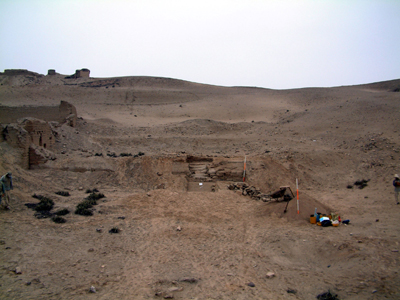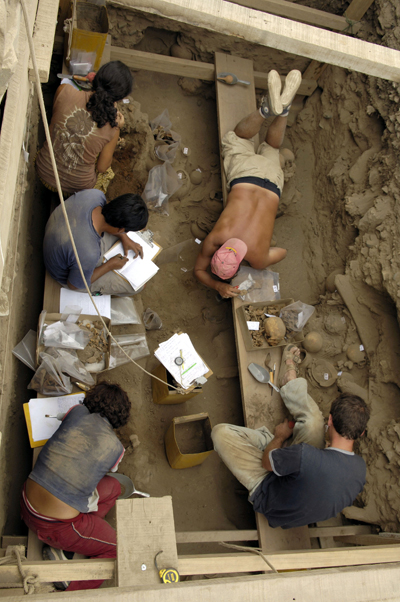
 View of Pyramid with Ramp n°16 form the South
View of Pyramid with Ramp n°16 form the South
The 2005 field season at Pachacamac
![]() Four main lines of investigation were followed this year: the chronology of the pyramids with ramps; the definition of the inner transit system within the Second Precinct or the pyramidal sector; the topographic and planimetric survey ; the anthropophysical study of mummies and human remains.
Four main lines of investigation were followed this year: the chronology of the pyramids with ramps; the definition of the inner transit system within the Second Precinct or the pyramidal sector; the topographic and planimetric survey ; the anthropophysical study of mummies and human remains.
The chronology of the pyramids with ramps is being defined via precisely placed excavations within strategic loci in pyramids n°11 and 14. It is worth recalling that the explanatory model which serves as a working hypothesis refers to dynastic succesion: each pyramid is the palace of a chief who built it, occupied it during his reign and was buried inside it when he died. His successor then built his own pyramid palace. Hence our goal is to determine as precisely as possible, for each of the pyramids, the moment of their foundation, the length of occupation and the date of voluntary abandonment.
The clearing of the pyramids and the survey of the circulation system within the Second Precinct have revealed very interesting features.
With regard to the architectural typology of pyramids with ramps previously established (Eeckhout 1999), it has been confirmed that Pyramid 11 is a “type C” pyramid with ramp, i.e. it possesses a central ramp. This fact was was not obvious during preliminary investigations, since the previous plan of Paredes and Farfán (1982) does not even include this building within the rubric of pyramids with ramps. It was later surmised that the building corresponded to this model. The reason why it was not previously considered as such is that it has been extensively remodeled; entrances have been closed; walls and structures have collapsed. Such a phenomenon has also been observed at Pyramid 15, excavated in 2003 and 2004.
Pyramid 14, however, was identified as such back in 1995. It should be noted that this pyramid has a very small forecourt whose original entrance could not be detected since it was covered by structures related to pyramid 11. Excavations and preliminary mapping in the east side of this pyramid suggest the possibility that the structures discovered there are related to another pyramid provisionally named pyramid 16. Would it be the case these are three pyramids from Quarter B that where explored this season. We will return to this point later.
With regard to the of general occupation of the pyramids, our excavations have further confirmed that the upper platform that rises above the plaza shows traces of domestic use during the Late Intermediate Period, even possibly after abandonment, while the rooms around the upper platform show no traces of such use, which suggests that they were used for other types of activities, such as sleeping quarters, private reception rooms, cult rituals, or depositories for sacred artefacts. The voluntary abandonment process including deposition of offerings and the sealing of access is very clear in pyramid 11, and the results of this process can possibly be found in pyramid 16 (although further excavation is needed to confirm this) and yet such the evidence for such is not clear in pyramid 14, which seems to have been abandoned ex-abrupto during the Late Horizon, or at the moment of the Conquest between 1533 y 1535. It could be that Burial E35 (an animal provisionnally identified as a kind of feline or dog), corresponds to an abandonment offering, but this pyramid was also used for burials during the Late Horizon.
In general terms it appears that that Pyramid 11 had two successive phases, while Pyramid 14 only had one. It would seem inappropriate to comment too much on Pyramid 16, since only one test pit was placed there.
Surface pottery at Pachacamac always belongs to the later periods and includes Inca material. In the case of Pyramid 14, we have found in the layers under the pyramid structure Ychsma sherds diagnostic of the Inca period (Ychsma Tardio B). Although this material awaits further analysis, and we need the results of absolute dating for the context, it is probable that this pyramid is of Late Horizon construction. This is unusual since up to now all the pyramids excavated by the Ychsma Project date from the Late Intermediate Period, with some domestic, ritual or funerary reoccupation during the Late Horizon until colonial times.
2. Excavations in Uhle’s cemetery 1
The Cemetery uncovered at the end of the 2004 field season beneath the rear plaza and structures of Pyramid with ramp n°13 was explored more extensively and to a greater depth this season. It was further confirmed that it extended over a greater area than previous imagined and that the superimposed burials reach a depth of several meters. Low walls and benches from the Late Horizon were encountered in the upper layers and these correspond to remodeling of the the rear plaza of the pyramid under the Incas. These structures are associated with a domestic occupation and a refuse deposit. Beneath the human sacrifices and the pre-Inca burial found in 2004 we discovered other tombs, older ones, corresponding to the late Middle Horizon, i.e. 8 to 10th century AD. These burials comprise several gravelots, and some of them combine man, women and child together, which may indicate that these are family burials, whose death is perhaps related to some epidemic. Anthropological and bioarchaeological analysis will check this hypothesis. It has been noted that the latest burials, an unusual proportion of which show traces of severe pathological abnormalities (syphilis, cancer, etc) are different from older ones, whose general state of health is normal. Hence it has been deduced that the pre-Hispanic practice of bringing sick people to Pachacamac in the hope that the deity who had his sanctuary there, in front of the cemetery, would cure them, probably took root during the Late Intermediate Period and became very prevalent during the Late Horizon under the Inca regime. Laboratory studies of the remains will allow to confirm these hypotheses. At present, it can be stated that there are three levels in the Cemetery :
(1) sacrificed people and mummies from late periods ;
(2) bundles with numerous grave goods from the Middle Horizon ;
(3) a lower level with individuals extended on their back, a feature indicative of an earlier period related to the Lima culture.
This level will be excavated in a future field season. Tombs from other periods, including funerary chambers with wooden roofs and some with stone walls, have been detected in the cemetery, but are awaiting excavation.
![]()